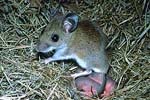 Description: Color varies greatly with habitat and geographic area. Often grayish to reddish brown above; white below. Tail distinctly bicolored and short-haired. 2 forms in eastern part of range: woodland and prairie. Woodland form has much longer tail and larger feet, ears, and body than prairie form. Woodland form: L 4 5/8 –8 3/4" (119–222 mm); T 13/4 –4 7/8" (46–123 mm); HF 5/8 –1" (16–25 mm); E 3/4–7/8" (18–21 mm); Wt 3/8–1 1/4 oz (10–33 g). Prairie form: L 4 1/8 –6 3/8" (106–162 mm); T 1 7/8–2 5/8" (48–68 mm); HF 1/2–3/4" (14–19 mm); E 1/2–5/8" (12–16 mm); Wt 3/8–7/8 oz (12.2–25.6 g).
Description: Color varies greatly with habitat and geographic area. Often grayish to reddish brown above; white below. Tail distinctly bicolored and short-haired. 2 forms in eastern part of range: woodland and prairie. Woodland form has much longer tail and larger feet, ears, and body than prairie form. Woodland form: L 4 5/8 –8 3/4" (119–222 mm); T 13/4 –4 7/8" (46–123 mm); HF 5/8 –1" (16–25 mm); E 3/4–7/8" (18–21 mm); Wt 3/8–1 1/4 oz (10–33 g). Prairie form: L 4 1/8 –6 3/8" (106–162 mm); T 1 7/8–2 5/8" (48–68 mm); HF 1/2–3/4" (14–19 mm); E 1/2–5/8" (12–16 mm); Wt 3/8–7/8 oz (12.2–25.6 g).
- Warning The droppings of the Deer Mouse have been associated with a sometimes fatal illness in humans called hantavirus. Never vacuum or sweep mouse droppings; thoroughly wet the area with a disinfectant, then carefully wipe up the droppings with a wet cloth.
- Similar Species Because it is the most common species in many small mammal communities and is exceedingly variable, the Deer Mouse can be difficult to distinguish from other Peromyscus species. In East, White-footed Mouse’s tail is shorter than that of woodland form (tail of woodland form is more than half total length), and its tail and hindfeet are longer than those of prairie form (prairie form’s tail is less than half total length). In West, Piñon and Northern Rock mice have much longer ears. Most other western species have shorter tails.
- Breeding Breeding season is variable, usually during the period that provides the best environment and food for raising young. Several litters per year of 2–7 young each; gestation 21–24 days.
- Sign Prairie form: small burrows in ground or nests in raised areas, if available. Woodland form: nests in hollow logs. Western forms: nests in such protected places as underground burrows, clumps of vegetation, hollow limbs on or above the ground, and rock crevices, among others.
- Tracks: Similar to White-footed Mouse.
- Habitat Exceedingly variable: prairies and other grasslands; brushy areas; woodlands.
- Range n West, s Yukon and Northwest Territories to Mexico; in East, Hudson Bay to Pennsylvania and s Appalachians, and across northern tier of states and south into c Arkansas and e Texas.
- The Deer Mouse occurs over a large geographic area and range of habitats, and is highly variable in appearance. More than 100 subspecies have been described. In the eastern portion of its range, there are two primary forms: the prairie and the woodland. The smaller prairie form (P. m. bairdii) occurs throughout much of the Midwest, whereas the many woodland forms occur in the Alleghenies and northward. It is presumed that the prairie and woodland forms in the eastern region form a continuous series of interbreeding populations whose habitats range from grasslands through brushy terrain to woodlands. The forms at the end of this continuum overlap in some areas, but they are separate morphologically and ecologically and do not interbreed. Thus they act as species, although they are not described as such and are referred to mainly as subspecies. This type of geographic pattern, called circular overlap, occurs occasionally but defies traditional taxonomic treatment, as it happens in a continuum, with interbreeding populations connecting the whole. Deer Mice are often highly arboreal. They feed on various foods, including seeds and nuts, small fruits and berries, insects, centipedes, and the subterranean fungus Endogone. The Deer Mouse caches food for winter use, routinely storing seeds and small nuts in hollow logs or other protected areas, but not as extensively as the White-footed Mouse. The most important foods of the prairie form include seeds of foxtail grass and wheat, among other sorts of seeds, as well as caterpillars and corn. The prairie form is common in cultivated areas and remains even during harvesting and plowing periods. It may have additional small refuge burrows as well as home burrows. The woodland form feeds on woodland nuts, seeds, and fruits as well as insects and other invertebrates. In the West, the Deer Mouse occurs in myriad habitats, feeding on the various seeds, fruits, nuts, caterpillars, and other insects available. Practically all predators of suitable size prey on this species, and since it is so common, it serves as a diet mainstay of many animals.